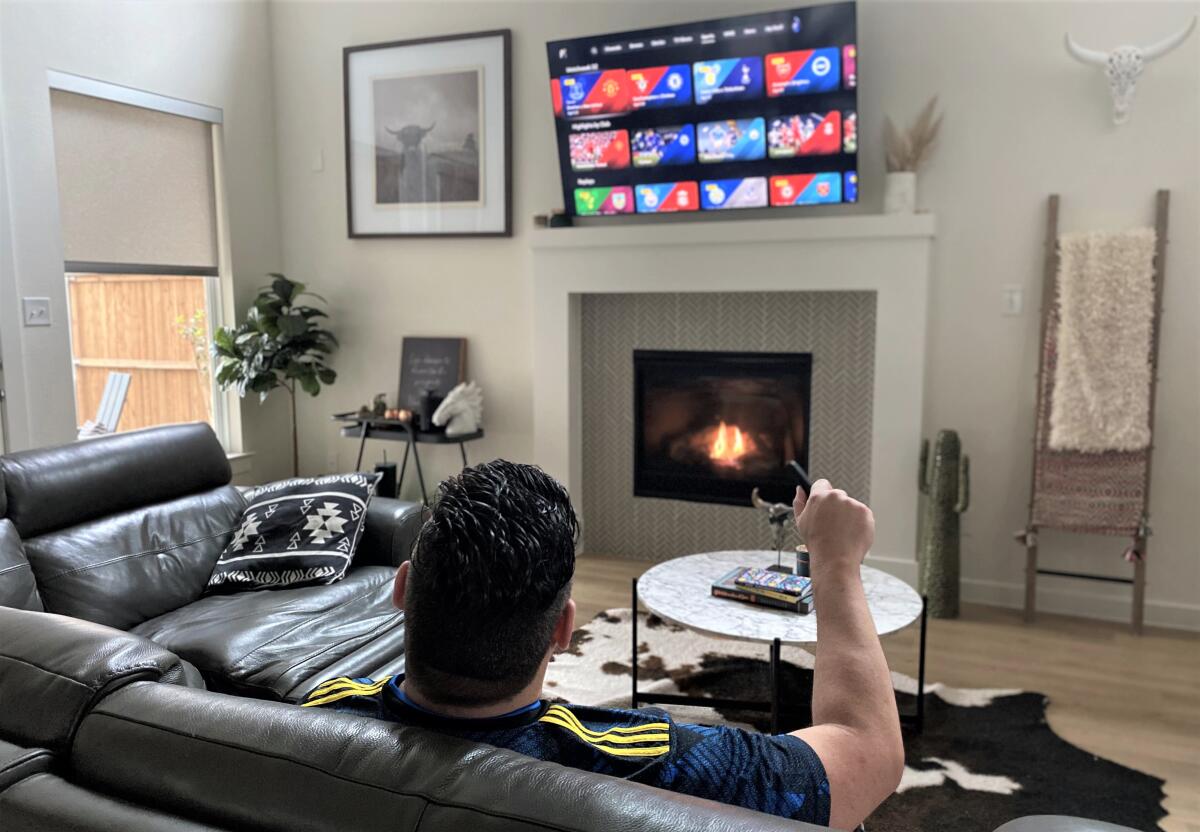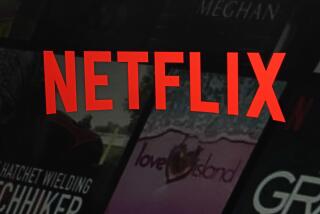You can watch more soccer than ever, but there are hurdles for streamers and fans

Eric Vieira is in the habit of waking early on the weekends, flipping on the TV and surfing through the cable channels to find the top European soccer games.
So when broadcasts of those games began moving from regular broadcast TV, known as linear, to streaming services a couple of years ago, he cut the cord and canceled his $140 cable package. Now he pays about the same amount to subscribe to 10 streaming services while the number of games he has access to has increased dramatically.
“I wanted to watch just the EPL, the big leagues, the big game,” he said.
Now he stumbles across teams and leagues he hasn’t seen before.
“It’s kind of like an added perk,” said Vieira, an educational consultant in suburban Dallas. “I wouldn’t say that’s the reason I signed up for it. But I enjoy that that’s there.”
What’s there is more than 2,400 games a year from five continents on CBS streaming service Paramount+; all 380 matches from Spain’s La Liga and 306 Bundesliga matches on ESPN+; and more than 200 Premier League matches, plus hundreds of hours of documentary and feature programming, on NBCUniversal’s Peacock.
The Galaxy will meet Chivas of Guadalajara while LAFC will play Club América in August at SoFi Stadium.
It’s there around the clock, accessible on a cell phone, tablet, computer or a smart TV. Where once viewers had difficulty finding international soccer games in the U.S., now it’s almost impossible to miss them.
“There’s no better time to be a soccer fan in America than right now, with the amount of soccer or football that is offered to you,” said Rick Cordella, the executive vice president and chief revenue officer for Peacock.
The reason, of course, is technology. Streaming services allow providers to offer virtually unlimited programming through the internet. While that’s also true of entertainment-content streaming services such as Netflix, Apple+ and Hulu, the new paradigm has allowed soccer fans to become their own program directors, choosing which games to watch and when.
“I don’t know if it’s the most widely distributed sport but soccer, in many ways, is one of the most attractive sports to put on streaming services. For a lot of reasons,” said Sean McManus, chairman, CBS Sports, which offers more than a dozen soccer properties on Paramount+, including the Champions and Europa league tournaments, the NWSL, professional leagues in Italy, Brazil and Argentina, and original soccer documentaries.
The value of soccer content was something few broadcast executives appreciated just a generation ago, when there was virtually no English-language soccer coverage on TV in the U.S., even in the early days of cable. Growing up in San Diego, LAFC coach Steve Cherundolo, who would go on to compete in three World Cups, remembers watching bootleg videotapes of European games. It was the only soccer he could get.
When there was live coverage, it was often poor. TNT missed important goals from a quarterfinal and semifinal of the 1990 World Cup because it was showing a commercial in the first instance and a picture of the World Cup trophy in the second.
The youth and diversity of the U.S. soccer audience today is the sweet spot where soccer and streaming content meet. According to a 2021 survey by Gilt Edge Soccer Marketing, the average age of an American soccer fan is 35 and nearly 70% are under 40, the youngest for any professional sport in the U.S. It’s also more diverse in terms of gender and ethnicity, making it extremely attractive to advertisers.
The Galaxy won 2-1 to stay unbeaten at home against LAFC, which had three goals disallowed by the officials, the final one deep in stoppage time.
Nearly two-thirds of people in that millennial age group watch live streaming content regularly. So by streaming soccer, content providers are meeting this young, diverse and desirable demographic where it already is — online.
“What we’ve seen in the early term is about half of our subscribers are under the age of 35,” said John Lasker, vice president of digital media programming for ESPN and ESPN+, which debuted four years ago and offers soccer content from more than a dozen countries and 24 competitions. “That’s not because that’s specifically who we decided to target. That’s just naturally the early adopters of streaming.”
The age gap is real, which is why Vieira, 38, is comfortable managing content from a number of sources, yet still has to coach his 74-year-old father John through the process of accessing streaming services on his computer. That’s a gap that soccer fans must learn to bridge, Lasker said, because the amount of content moving from broadcast to internet TV is only going to grow.
“I don’t think there’s any doubt this is the future, what fans are expecting,” said Lasker, who oversees about 22,000 annual sports events, from cricket to auto racing, on ESPN+. “We’re going to continue to evolve with technology and evolve with where fans are and the devices and the experiences they want.”
McManus agreed.
“Streaming is going to continue to be one of the primary ways that people will consume soccer content in this country. That’s a fact,” he said.
The numbers back that conclusion.
In the last 13 months the Paramount+ soccer audience grew 111% over the viewership it had under its predecessor, CBS All Access, while its overall subscription base, at $4.99 a month, has nearly doubled to 32.8 million. ESPN+, which costs $6.99 a month, has gathered 21.3 million subscribers since its launch four years ago, and NBC Universal’s Peacock had 24.5 million active accounts, at $4.99 a month, by the end of 2021.
“The rapidly growing amount of soccer content available via streaming is merely a function of global supply and demand for it,” said David Carter, a professor of sports business at the USC Marshall School of Business. “As fans demand soccer on their terms and are willing to pay for it, the industry will gladly deliver it provided they can do so with reliable technology.”
More than three-quarters of all U.S. households already subscribe to at least one streaming service, according to a study by the Leichtman Research Group. The global streaming industry as a whole is forecast to top a quarter-trillion dollars by 2030, according to numerous analysts.
This time El Tráfico was decided on a video monitor, with referee Chris Penso taking away what appeared to be a tying goal by LAFC’s Latif Blessing goal deep into stoppage time.
Though soccer isn’t the only reason for that growth, it is among the top three drivers of new subscriptions to Paramount+, which just celebrated its first anniversary, and the sport has shared in the profits.
“The economic model we have for soccer works for us very well. And it enables us to pay more in rights [fees] than we would be able to if this product was just on linear television,” McManus said of Paramount+, which receives revenue from both advertising and subscription fees.
That works only if the audiences continue to buy in to the streaming model, Carter said.
“There will be an inflection point in the years to come as the streaming audience continues to grow and eventually overtakes traditional TV,” he said. “The key question, one in which billions of dollars are at stake, is precisely when this will happen. Migrating too far toward a primary reliance on streaming too soon or too late would be a costly financial mistake for media companies.
“It is vital to appreciate that viewer acceptance and transition to streaming varies greatly by age, income and other variables such as the type of content — and all of this affects profitability.”
Take NBCUniversal’s six-year, $2.7-billion deal with the English Premier League, the most popular soccer property in the world. The overall price of the deal is more than 10 times what the broadcaster paid for the EPL rights a decade ago, and about six times what it paid per season.
When Peacock launched 22 months ago, it picked up the streaming content previously carried on NBC Sports Gold, making all 380 EPL games available, either live or on a delayed basis, to subscribers in one place. Peacock also carries hundreds of additional hours of league-branded programming, allowing a fan of relegation-bound Norwich City to watch his or her team just as often as a United fan can watch theirs. When Norwich City begins play in the second-tier Championship next season, fans can continue following the Canaries on ESPN+.
“It’s a great time to be a soccer fan,” said Jeffrey Gerttula, executive vice president and general manager of CBS Sports Digital.
There are drawbacks. Where once one basic cable package provided access to the majority of televised soccer available, now viewers need to subscribe to multiple streaming services, which requires access to a robust WiFi network as well.
U.S. was put in a group with England, Iran and the winner of a June playoff involving Wales, Scotland and Ukraine
Additionally the viewing experience on computers or hand-held devices is different, although that can be solved by streaming to a smart TV.
“It’s a different behavior. It’s not the same as just flipping between three channels,” Gerttula said. “But now, with a few apps, you can get more than you’ve ever had before. In terms of the overall value that you can get as a soccer fan and the completeness, there’s never been more.”
Yet if that content isn’t entertaining, compelling and well-produced, nobody will watch no matter how it reaches the screen. Technology might have changed how viewers watch soccer on TV, but it hasn’t changed why.
“The soccer audience is one of the most assertive, discerning and demanding audiences out there,” McManus said. “If you put on a product that isn’t authentic, you’ll get called out immediately. So much of the value of soccer is how you present it and the reputation that you have and the standing that you have in the marketplace.”










